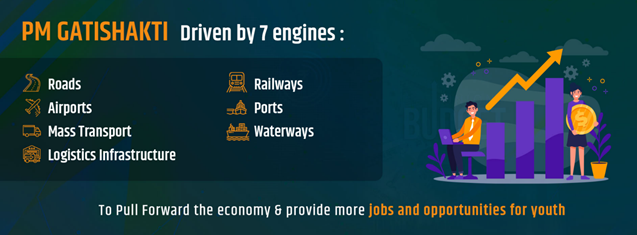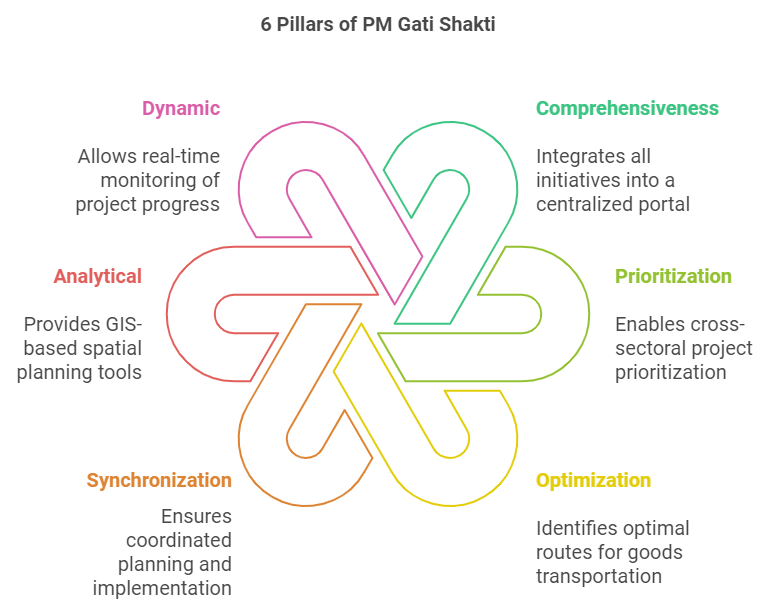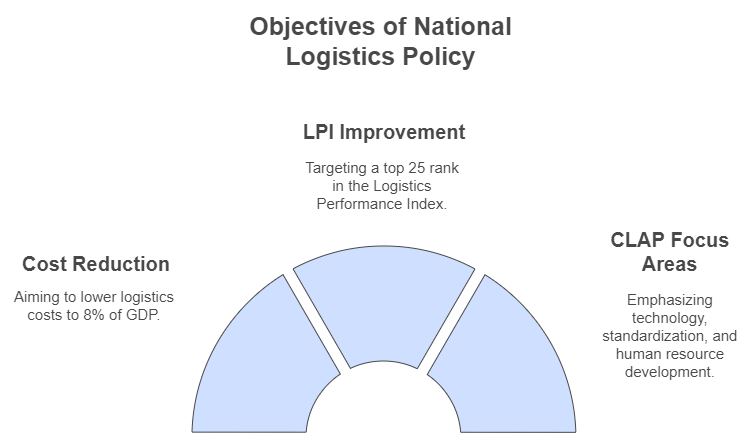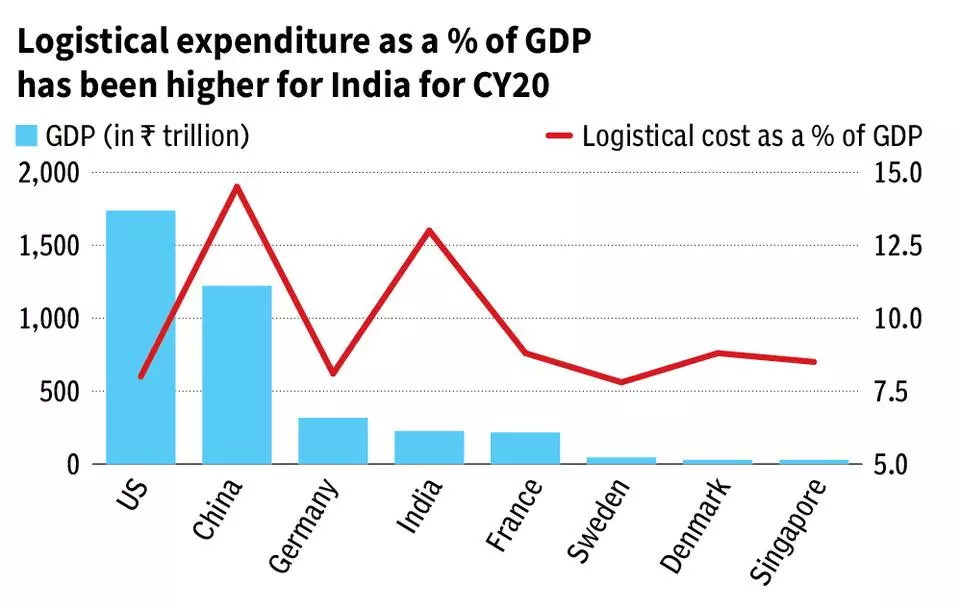Indian Economy
In-Depth - PM Gati Shakti: Transforming Infra & Connectivity
- 24 Oct 2024
- 15 min read
For Prelims: PM Gati Shakti National Master Plan, Bharatmala, Sagarmala, Inland Waterways, UDAN, Renewable Energy, Green Energy Corridor, PM Shri Schools, The Ministry of Skill Development and Entrepreneurship, Pradhan Mantri Gram Sadak Yojana (PMGSY), Pradhan Mantri Awaas Yojana-Gramin (PMAY-G), PM JanMan Portal, Particularly Vulnerable Tribal Groups (PVTG), Aspirational Districts,National Logistics Policy (NLP), World Bank's Logistics Performance Index (LPI), RFID-Based System, Dedicated Freight Corridors (DFCs), Gati Shakti Sanchar portal, 5G Services, Poor multimodal connectivity, E-commerce, Carbon Emissions, Artificial Intelligence (AI), Internet of Things (IoT), Public-private partnerships (PPPs), Electric Vehicles (EVs).
For Mains: Significance and Achievements of India's Logistic Sector, Key Issues Related to India's Logistics Sector.
Why in News?
Recently, the PM Gati Shakti National Master Plan marked its third anniversary, showcasing its infrastructure progress and renewed focus on India's logistics sector.
- This initiative has significantly impacted India's infrastructure and logistics sectors by integrating multimodal connectivity across various ministries and states.
What has been the Progress of PM Gati Shakti National Master Plan?
- Integrated Connectivity: The PM Gati Shakti National Master Plan was launched in 2021 as a digital platform designed to integrate various ministries, such as Railways and Roadways, for coordinated planning and execution of infrastructure projects.
- The initiative focuses on improving connectivity for people, goods, and services across different modes of transport, thereby enhancing last-mile connectivity and reducing travel time.
- Key Integrated Schemes:
- Bharatmala: A national highway development project.
- Sagarmala: A project focused on port infrastructure and coastal development.
- Inland Waterways: For efficient movement of goods via rivers.
- UDAN: A regional air connectivity scheme.
- Central Ministries and State Participation: The PM Gati Shakti National Master Plan has brought together 44 Central Ministries and 36 States and Union Territories (UTs).
- To ensure data accuracy and proper coordination, Standard Operating Procedures (SOPs) have been established for eight key infrastructure ministries and 15 social sector ministries, with more ministries and States/UTs being incorporated.
- Notable Achievements: The initiative has assessed 208 major infrastructure projects worth Rs 15.39 lakh crore across various ministries, adhering to PM Gati Shakti’s principles.
- Road Transport: The Ministry of Road Transport and Highways (MoRTH) planned over 8,891 kilometers of roads using the Gati Shakti platform.
- Railways: The Ministry of Railways planned more than 27,000 kilometers of railway lines under the National Master Plan.
- The completion of Final Location Surveys (FLS) increased significantly, with 449 FLS completed in FY 2022 compared to just 57 in FY 2021.
- Additionally, 434 railway projects under three economic corridors of the Ministry of Railways have been evaluated and shared with the PMO and they are Energy, Mineral, and Cement Corridors, High Traffic Density Corridors and Rail Sagar.
- Petroleum and Gas: The Ministry of Petroleum and Natural Gas (MoPNG) streamlined the Detail Route Survey (DRS) process, reducing the time required to generate reports from six to nine months to just one day using an electronic DRS system.
- Renewable Energy: A 13 GW renewable energy project linking Leh (Ladakh) to Kaithal (Haryana) through a ‘Green Energy Corridor’ achieved optimal alignment for inter-state transmission, boosting green energy capacity.
- Disaster Management in Goa: The state used the Gati Shakti platform to develop a disaster management plan for flood-prone areas along the Amona River.
- Education: The Department of School Education and Literacy used the National Master Plan portal to link PM Shri Schools with local industries for district-specific skill training.
- The Uttar Pradesh government employed the State Master Plan (SMP) portal to identify locations for new schools in underserved areas through the Pahunch Portal.
- Healthcare: The Ministry of Health and Family Welfare used the platform to map internet shadow areas and identify locations for new healthcare facilities.
- Skill Development: The Ministry of Skill Development and Entrepreneurship identified suitable locations for new training institutes near economic clusters.
- Rural Development: The Ministry of Rural Development integrated its Pradhan Mantri Gram Sadak Yojana (PMGSY) and Pradhan Mantri Awaas Yojana-Gramin (PMAY-G) schemes for better asset planning.
- Tribal Affairs: The Ministry of Tribal Affairs utilized the PM JanMan portal to identify infrastructure gaps for Particularly Vulnerable Tribal Groups (PVTG).
- District Master Plan (DMP) portal: The initiative is also being extended to the district level through the development of a District Master Plan (DMP) portal.
- This platform will assist district authorities in collaborative infrastructure planning, gap identification, and scheme implementation.
- A beta version of this portal has been launched for 28 aspirational districts, and user accounts were provided to these districts in September 2024.
What are Other Key Initiatives Taken to Boost the Logistics Sector?
- National Logistics Policy (NLP) 2022: The National Logistics Policy (NLP), launched in September 2022, is a comprehensive plan to transform India's logistics ecosystem.
- Its key goals are to reduce logistics costs, enhance infrastructure, and improve India's ranking in the World Bank's Logistics Performance Index (LPI).
- Unified Logistics Interface Platform (ULIP): ULIP is a digital platform that integrates 33 logistics-related systems across 10 ministries to facilitate seamless data exchange.
- It enables end-to-end cargo tracking and promotes transparency in logistics operations. Over 930 private companies are registered on ULIP, with numerous live applications for improved coordination.
- Logistics Data Bank (LDB): LDB is an RFID-based system that tracks the movement of containerized cargo in real-time, providing visibility into the transportation of EXIM goods across ports, railways, and highways.
- This system enhances transparency and enables stakeholders to monitor and optimize their supply chains.
- Multi-Modal Logistics Parks (MMLPs): The government has initiated the development of MMLPs to facilitate seamless transfer between different modes of transportation.
- These parks are designed to serve as hubs for freight movement, providing storage, warehousing, and value-added services under one roof.
- Dedicated Freight Corridors (DFC): India is developing Dedicated Freight Corridors (DFCs) to enhance the speed and efficiency of goods transport.
- The Western and Eastern DFCs are designed to decongest existing rail networks and provide faster, more reliable freight movement, particularly for heavy industries.
- LEADS (Logistics Ease Across Different States): The LEADS survey ranks states based on the efficiency of their logistics ecosystem.
- It encourages competition among states to improve infrastructure and services, driving overall improvement in logistics performance.
- Gati Shakti Sanchar Portal: The Gati Shakti Sanchar portal was launched to streamline Right of Way (RoW) approvals, essential for the rollout of telecom infrastructure.
- This initiative has accelerated the deployment of mobile towers and fiber networks, crucial for the growth of digital logistics solutions.
- 5G Rollout: The rapid deployment of 5G services across India, with over 13 crore subscribers in its first year, will enhance real-time tracking, autonomous vehicle deployment, and the efficiency of logistics operations.
- The government has sanctioned over 41,000 mobile towers for rural and remote areas to improve digital connectivity.
What are Major Issues Related to India's Logistics Sector?
- High Logistics Costs: India's logistics costs are substantially higher compared to global standards, making its products less competitive.
- While countries like Japan and Germany spend around 8-10% of their GDP on logistics, India’s logistics costs are between 13-14%, heavily impacting the cost structure of Indian goods.
- Fragmented and Unorganized Market: Over 90% of the logistics sector in India is unorganized, with numerous small players operating in silos.
- This fragmentation makes it challenging to integrate advanced technologies, standardize services, and improve efficiency.
- The sector lacks uniformity in regulations and coordination among various modes of transport.
- Inadequate Infrastructure: Despite significant strides, the Indian logistics infrastructure suffers from bottlenecks such as poor road conditions, outdated rail networks, and congested ports.
- For example, the average turnaround time for ships at major Indian ports has improved but still lags behind global benchmarks. These inefficiencies lead to delays, higher costs, and losses for businesses.
- Poor Multimodal Connectivity: Seamless integration across different modes of transport roadways, railways, airways, and waterways is lacking.
- Poor multimodal connectivity adds to inefficiency in moving goods. A large share of freight movement depends on roadways, which are prone to delays and higher costs, while railways and waterways remain underutilized.
- Insufficient Warehousing and Cold Chain Facilities: The Indian logistics sector suffers from a severe shortage of modern warehousing facilities, particularly in tier-2 and tier-3 cities.
- Furthermore, cold chain infrastructure remains inadequate, impacting the storage and transportation of perishables such as food products and pharmaceuticals. This adds to wastage and increases costs.
- Last-Mile Delivery Challenges: Last-mile logistics costs contribute significantly to the total cost of delivery, particularly in urban centers where traffic congestion, limited parking, and poor addressing systems add delays.
- For businesses like e-commerce, this inefficiency has a direct impact on delivery timelines and costs.
- Regulatory Complexities: The sector is bogged down by multiple regulatory frameworks and approvals at both the central and state levels.
- Delays in obtaining clearances, particularly for large-scale logistics projects, hinder infrastructure development.
- A lack of coordination among ministries also contributes to delayed project execution.
- Skill Gaps and Workforce Shortages: The logistics sector in India is one of the fastest-growing employment generators, yet it faces a severe shortage of skilled manpower.
- Supply chain management, warehousing operations, and technological proficiency are areas where the sector is lagging. Although initiatives have been launched to address these gaps, progress remains slow.
- Environmental Impact: The logistics sector is one of the largest contributors to carbon emissions in India.
- With road transportation being the dominant mode of freight movement, emissions are significant. While India is committed to reducing carbon intensity, adopting greener logistics practices remains a challenge for the industry.
Way Forward
- Focus on Multimodal Transport Solutions: India needs to emphasize the development of multimodal transportation solutions that seamlessly integrate road, rail, air, and water networks.
- This requires continued investment in Dedicated Freight Corridors, inland waterways, and improving port infrastructure.
- Enhance Technological Integration: The logistics sector must adopt cutting-edge technologies such as Artificial Intelligence (AI), Internet of Things (IoT), and blockchain to improve supply chain visibility, streamline operations, and reduce costs.
- Streamline Regulatory Frameworks: The government should introduce single-window clearances for logistics projects and harmonize rules across states.
- Streamlining regulatory processes will lead to faster infrastructure development and lower logistics costs.
- Improving Cold Chain Infrastructure: The government should promote investments in cold storage facilities and refrigerated transport to ensure the timely and safe delivery of perishables.
- Increase Private Sector Participation: Private sector participation is crucial for scaling up logistics infrastructure. Public-private partnerships (PPPs) should be encouraged in areas such as warehousing, cold storage, and transportation infrastructure.
- Skill Development and Workforce Training: The government must invest in skill development programs focusing on supply chain management, warehousing operations, and digital logistics. Strengthening vocational training and creating certification programs will help bridge the current skill gaps.
- Environmental Sustainability: The logistics industry must embrace greener practices to meet India's climate goals.
- This includes promoting the use of electric vehicles (EVs) for last-mile delivery, developing green corridors for freight transport, and incentivizing the adoption of clean energy in warehouses and logistics hubs.
UPSC Civil Services Examination, Previous Year Question (PYQ)
Prelims:
Q. With reference to ‘National Investment and Infrastructure Fund’, which of the following statements is/are correct? (2017)
1. It is an organ of NITI Aayog.
2. It has a corpus of `4,00,000 crore at present.
Select the correct answer using the code given below:
(a) 1 only
(b) 2 only
(c) Both 1 and 2
(d) Neither 1 nor 2
Ans: (d)
Mains:
Q. The Gati-Shakti Yojana needs meticulous coordination between the government and the private sector to achieve the goal of connectivity. Discuss.(2022)








